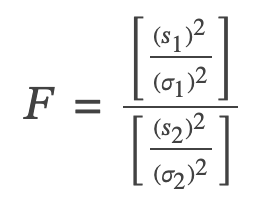Chapter 13: F Distribution and One-way Anova
Introductory
- Analysis of Variance: For hypothesis tests comparing averages between more than two groups
13.1 One-Way ANOVA
- ANOVA Test: determine the existence of a statistically significant difference among several group means.
- Variances: helps determine if the means are equal or not
- ANOVA Conditions
- Each population from which a sample is taken is assumed to be normal.
- All samples are randomly selected and independent.
- The populations are assumed to have equal standard deviations (or variances).
- The factor is a categorical variable.
- The response is a numerical variable.
- Ho: μ1 = μ2 = μ3 = … = μk
- Ha: At least two of the group means μ1, μ2, μ3, …, μk are not equal. That is, μi ≠ μj for some i ≠ j.
- The null hypothesis: is simply that all the group population means are the same.
- The alternative hypothesis: is that at least one pair of means is different.
- Ho is true: All means are the same; the differences are due to random variation.
- Ho is NOT true: All means are not the same; the differences are too large to be due to random variation.
13.2 The F Distribution and the F-Ratio
F-distribution: theoretical distribution that compares two populations
There are two sets of degrees of freedom; one for the numerator and one for the denominator.
To calculate the F ratio, two estimates of the variance are made.
Variance between samples: An estimate of σ2 that is the variance of the sample means multiplied by n (when the sample sizes are the same.).
Variance within samples: An estimate of σ2 that is the average of the sample variances (also known as a pooled variance).
- SSbetween: the sum of squares that represents the variation among the different samples
- SSwithin: the sum of squares that represents the variation within samples that is due to chance.
MS means: "mean square."
MSbetween: is the variance between groups
MSwithin: is the variance within groups.
Calculation of Sum of Squares and Mean Square
- k: the number of different groups
- nj: the size of the jth group
- sj: the sum of the values in the jth group
- n: total number of all the values combined (total sample size: ∑nj)
- x: one value→ ∑x = ∑sj
- Sum of squares of all values from every group combined: ∑x2
- Between-group variability: SStotal = ∑x2 – (∑𝑥2) / n
- Total sum of squares: ∑*x^*2 – (∑𝑥)^2n / n
- Explained variation: sum of squares representing variation among the different samples→ SSbetween = ∑[(𝑠𝑗)^2 / 𝑛𝑗]−(∑𝑠𝑗)^2 / 𝑛
- Unexplained variation: sum of squares representing variation within samples due to chance→ 𝑆𝑆within = 𝑆𝑆total – 𝑆𝑆between
- df**'s for different groups (df's for the numerator)**: df = k – 1
- dfwithin = n – k*:* Equation for errors within samples (df's for the denominator)
- MSbetween = 𝑆𝑆between / 𝑑𝑓between: Mean square (variance estimate) explained by the different groups
- MSwithin = 𝑆𝑆within / 𝑑𝑓within: Mean square (variance estimate) that is due to chance (unexplained)
- Null hypothesis is true: MSbetween and MSwithin should both estimate the same value.
- The alternate hypothesis: at least two of the sample groups come from populations with different normal distributions.
- The null hypothesis: all groups are samples from populations having the same normal distribution
F-Ratio or F Statistic
- 𝐹 = 𝑀𝑆between / 𝑀𝑆within
- F**-Ratio Formula when the groups are the same size:** 𝐹 = 𝑛⋅𝑠𝑥^2 / 𝑠^2 pooled
- where …
- n: the sample size
- dfnumerator: k – 1
- dfdenominator: n – k
- s2 pooled: the mean of the sample variances (pooled variance)
- sx¯^2: the variance of the sample means
13.2 Facts About the F Distribution
- Here are some facts about the F distribution.
- The curve is not symmetrical but skewed to the right.
- There is a different curve for each set of dfs.
- The F statistic is greater than or equal to zero.
- As the degrees of freedom for the numerator and for the denominator get larger, the curve approximates the normal.
13.4 Test of Two Variances
In order to perform a F test of two variances, it is important that the following are true:
- The populations from which the two samples are drawn are normally distributed.
- The two populations are independent of each other.

F has the distribution F ~ F(n1 – 1, n2 – 1)
where n1 – 1 are the degrees of freedom for the numerator and n2 – 1 are the degrees of freedom for the denominator.
F is close to one: the evidence favors the null hypothesis (the two population variances are equal)
F is much larger than one: then the evidence is against the null hypothesis
A test of two variances may be left, right, or two-tailed.
Examples